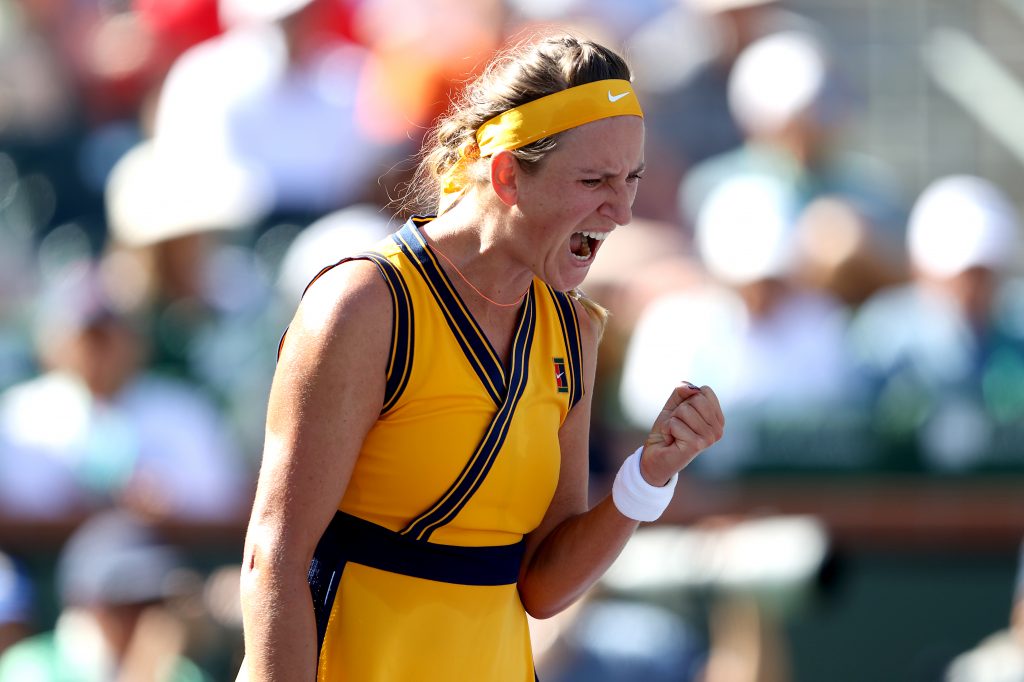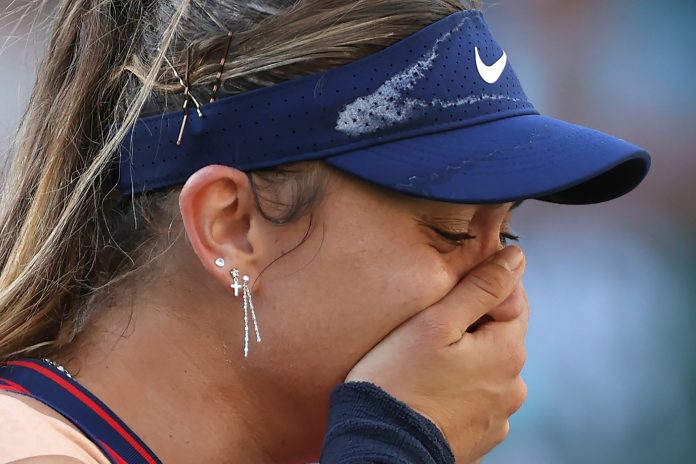Bill Simons
Indian Wells
Victoria Azarenka is one of the most fascinating sportswomen of our era.
She was never a sweet tennis darling like Coco Gauff or Emma Raducanu. She’s hardly an icon, let alone a household name. You don’t see her in snazzy ads and there are no Netflix docu-series that track her every move.
Still, Azarenka has given us great drama. It’s not just because as a young Belarusian girl she found herself alone in New York or that an NHL goalie hosted her for many years in Arizona.
Young Vika collected two Australian Opens, but she was known almost as much for her piercing grunts and born-to-be-wild rock-and-roll boyfriend as for her Slam victories. When she showed signs of entitlement, her no-nonsense grandmother, who toiled at two jobs back in Belarus, brought the hammer down with some tough love advice. It stuck.
Vika would go on to have an unexpected pregnancy and soon became perhaps the foremost single mother in sports. Like Bjorn Borg and Roger Federer, she has a son named Leo. But quite obviously, unlike them, Leo’s birth interrupted her play. Worse yet, she endured a long, bitter custody battle that limited her travel, tested her will, and gave her an extraordinary resilience.
She reemerged and in 2020, won the Cincy Masters and reached the US Open final.
But this year she had to endure a tough quarantine in Australia, as well as small injuries. She suffered painful losses and withdrew from many tourneys. Goodness, with the rise of Aryna Sabalenka she was no longer even No. 1 in Belarus. But here in the desert, she downed the two-time Slam winner Petra Kvitova en route to the semis, where she came from a set down to beat Jelena Ostapenko and score a triumph that would take her to her 41st WTA final.
There, to win a record third Indian Wells title, she would face a surprising but considerable foe.
The appealing 23-year-old, Paula Badosa, ticks off many boxes. Like John McEnroe and Vitas Gerulaitis, she was born in New York. And like many a champion – Andy Murray, Marat Safin, Garbine Muguruza and Svetlana Kuznetsova – she went to train in Spain. Her parents are deep into the fashion industry. Like Osaka, Serena and Venus, Paula tells us her fashion preferences: simple, basic and casual.
Like Alexander Zverev and many others in tennis, her romantic partner is a model. And like Naomi Osaka, she’s battled with bouts of depression. When she was a junior phenom, they said she’d be the next Maria Sharapova. But she lost her love of the game and spoke of the cruel expectations and suffering that is intrinsic in tennis.
But here, it was Badosa’s foes who suffered: the Spaniard thrived on Indian Wells’ slow surface and scored four wins over top-20 players: Coco Gauff, Barbora Krejcikova, Angie Kerber and Ons Jabeur.

Under a blazing sun Badosa and Azarenka exchanged fiery blasts in an epic that some claimed was the women’s match of the year. Whiplash-inducing momentum swings defined the ferocious shoot-out that was completely captivating. After faltering on three breakpoints, Paula retrieved an overhead on the stretch and blasted a blistering return to break serve and draw first blood. But Azarenka blasted a return of her own to even the first set at 4-4.
Badosa squandered six break points, but finally she again broke to go up 6-5. So what? Vika focused; she ran; she unleashed her power. Never mind that she was nine years older than her foe. She, too, scored a second break and forced a first-set tiebreak. But then she whiffed. She double-faulted and hit an errant bailout dropshot to go 0-4 down in the breaker.
No matter. Azarenka is a warrior. She won five of the next six points and seemed poised to subdue the Spaniard. But Badosa promptly rallied and unleashed a crosscourt backhand to the open court to claim the tiebreak 7-5. “This is absolutely absurd stuff,” said broadcaster Mike Cation, “What absolutely priceless tennis from these two.”
Despite her first-set loss, the veteran Vika seemed fresher and more motivated than Badosa. She strode with confidence – her energy soared. She hit a brilliant running backhand crosscourt flick and in 32 minutes claimed the second set 6-2. “Never mind going to space,” commented Craig Gabriel, “This tennis is stratospheric.”
In the third set, the momentum again swung as the Spaniard broke to go up 2-0. But Vika called out, “Let’s go!” Her camp yelled, “Believe! All day!” The Belarusian mother broke back. But at 4-4, up 40-15 serving, Badosa was seemingly in command.
Perhaps she felt the pressure of being in the biggest match of her life: disaster struck. She double-faulted and mis-hit three pedestrian forehands. The crowd roared. Vika broke to go up 5-4 and gained a 30-0 lead, just two points from a delicious triumph. But Vika veered. She suffered four inexplicable errors off the ground and lost seven points in a row.
Fittingly, the match went to a deciding tiebreak where Azarenka double-faulted and hit a forehand error, while Badosa blasted a backhand down the line to go up 3-0. “It’s been a fairy tale, the way Badosa has responded to adversity,” noted broadcaster Jason Goodall.
After 3:04 the Spaniard hit a forehand winner and rolled on the ground in disbelief as she scored a jaw-dropping, chest-heaving, mind-boggling 3:04 victory, 7-6, 2-6, 7-6, to become the first Spanish woman ever to prevail at Indian Wells. Just as Naomi had done in 2018 and Bianca Andreescu did in 2019, Badosa gave Indian Wells fans an appealing surprise winner. The epic battle was the longest women’s match in Indian Wells history and the longest of the WTA season.
Gracious in defeat, Azarenka joked that her son would enjoy playing with her smaller trophy and shared how she was touched when Badosa told her that, when she was young, she’d been inspired by Vika. “That’s part of my motivation to play,” said Azarenka. “To inspire people to…keep pushing the boundaries for women in sports, careers, anywhere. It’s very touching. It’s always important to be a good player, a better person off the court. If I inspire people that’s only more motivating for me.”
Young Badosa comes out of Spain’s almost metaphysical tradition. Gentleman Rafa Nadal often speaks of the role of doubt in tennis and the importance of graciousness. Spain’s former Davis Cup leader, Alex Corretja, said, “We have to be humble. It’s transcendental. We have to suffer, maintain and be quiet. I will sacrifice and think globally.”
Similarly, Badosa recently noted, “You see everyone suffering…the key is to find that joy in the suffer.”
Today she and delighted fans in a desert stadium found joy in an intergenerational battle that will long be remembered.
Badosa also spoke of finding joy in diversions: dinners, shopping and golf. Being a professional doesn’t mean just staying in your hotel room. The Spaniard, who began the year at No. 87 will now be No. 13. She spoke her truth In the same interview room where years ago Justine Henin coined the immortal saying, “Impossible is nothing.”
Paula said, “I’ve learned this week that nothing is impossible. If you fight, if you work, after all these years, you can achieve anything. That’s the first message…And to dream…I have been through tough moments. I never stopped dreaming. That’s what kept me working hard and believing until the last moment. Today was the same, so I’m really proud of it…Every morning I wake up, and my dream is to win a tournament like this.”






















I think this was not the longest match of 2021. Didn’t Muguruza and someone have a Night match at the USO that was about 3:30?